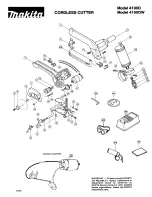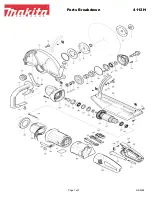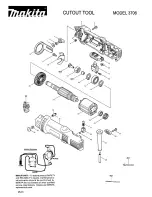
7
SAFETY
10) Important Safety Instructions for All Battery Chargers
•
Before using the charger, read all instructions and cautionary markings on the charger, battery pack and product
using the battery pack.
•
DO NOT
attempt to charge the battery pack with any chargers other than the ones in this manual. The charger
and battery pack are specifically designed to work together.
•
These chargers are NOT intended for any uses other than charging DeWALT rechargeable batteries. Any other
uses may result in risk of fire, electric shock or electrocution.
•
DO NOT
expose the charger to rain or snow.
•
Pull by the plug rather than the cord when disconnecting the charger. This will reduce the risk of damage to the
electric plug and cord.
•
Make sure that the cord is located so that it will not be stepped on, tripped over or otherwise subjected to
damage or stress.
•
DO NOT
place any object on top of the charger or place the charger on a soft surface that might block the
ventilation slots and result in excessive internal heat. Place the charger in a position away from any heat source.
The charger is ventilated through slots in the top and the bottom of the housing.
•
DO NOT
operate the charger with a damaged cord or plug.
•
DO NOT
operate the charger if it has received a sharp blow, been dropped or otherwise damaged in any way.
Take it to an authorized service center.
•
DO NOT
disassemble the charger; take it to an authorized service center when service or repair is required.
Incorrect reassembly may result in a risk of electric shock, electrocution or fire.
•
Disconnect the charger from the outlet before attempting any cleaning. This will reduce the risk of electric
shock. Removing the battery pack will not reduce this risk.
•
NEVER
attempt to connect two chargers together.
•
The charger is designed to operate on standard 120 volt household electrical power. Do not attempt to use any
other voltage. (This does not apply to vehicular chargers.)
•
When operating a charger outdoors, always provide a dry location and use an extension cord suitable for
outdoor use. Use of a cord suitable for outdoor use reduces the risk of electric shock.
•
DO NOT
use an extension cord unless it is absolutely necessary. Use of improper extension cord could result in
risk of fire, electric shock or electrocution.
•
An extension cord must have adequate wire size (AWG or American Wire Gauge) for safety. The smaller the
gauge number of the wire, the greater the capacity of the cable, that is, 16 gauge has more capacity than 18
gauge. An undersized cord will cause a drop in line voltage resulting in loss of power and overheating. When
using more than one extension to make up the total length, be sure each individual extension contains at least
the minimum wire size. The table below shows the correct size to use depending on cord length and nameplate
ampere rating. If in doubt, use the next heavier gauge. The lower the gauge number, the heavier the cord:
Minimum Gauge for Cord Sets
Ampere Rating (Amps)
Volts
Total Length of Cord
120 V
25' (7.6 m) 50' (15.2 m) 100' (30.5 m) 150' (45.7 m)
240 V
50' (15.2) 100' (30.5) 200' (61.0) 300' (91.4)
More Than
Not More Than
AWG
0
6
18
16
16
14
6
10
18
16
14
12
10
12
16
16
14
12
12
16
14
12
Not Recommended








































